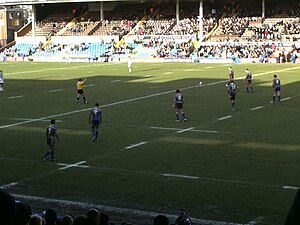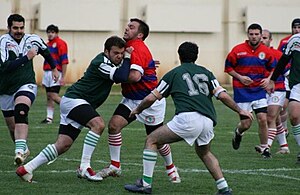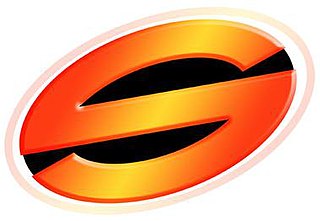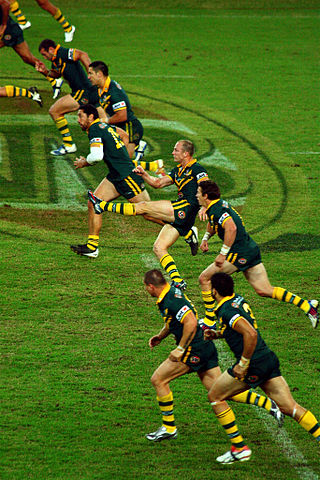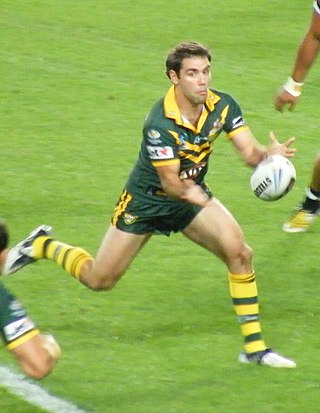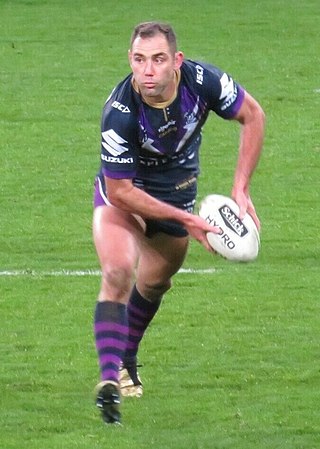 An attacking player attempts to evade two defenders. | |
| Highest governing body | International Rugby League |
|---|---|
| Nicknames | League, RL, rugby, rugby XIII (used throughout Europe) League, footy, football (used throughout Oceania) |
| First played | 7 September 1895, Yorkshire, Northern England (post schism) |
| Characteristics | |
| Contact | Full |
| Team members | 13 |
| Mixed-sex | Single |
| Type | Team sport, outdoor |
| Equipment | Rugby league ball |
| Venue | Rugby league playing field |
| Presence | |
| Country or region | Worldwide (most popular in Oceania, northern England and southern France) |
Rugby league football, commonly known as rugby league in English-speaking countries and rugby XIII in non-Anglophone Europe and South America, and referred to colloquially as football, footy, rugby, or league in its heartlands, is a full-contact sport played by two teams of thirteen players on a rectangular field measuring 68 m (74 yd) wide and 112–122 m (122–133 yd) long with H-shaped posts at both ends. [1] It is one of the two major codes of rugby football, the other being rugby union. [a] It originated in 1895 in Huddersfield, Yorkshire, England, as the result of a split from the Rugby Football Union (RFU) over the issue of payments to players. [2] The rules of the game governed by the new Northern Rugby Football Union progressively changed from those of the RFU with the specific aim of producing a faster and more entertaining game to appeal to spectators, on whose income the new organisation and its members depended.
Contents
- Etymology
- History
- Rules
- Laws of the game
- Comparison with rugby union
- Comparison with gridiron codes
- Positions
- Backs
- Forwards
- Rugby league worldwide
- World Cup
- Oceania and South Pacific
- Europe
- North America
- Other countries
- Domestic professional competitions
- Variants
- Touch
- OzTag
- League Tag
- Nines
- Sevens
- Attendances
- International
- Domestic
- See also
- Footnotes
- References
- Further reading
- External links
In rugby league, points are scored by carrying an oval ball and touching it to the ground beyond the opposing team's goal line; this is called a try , and is the primary method of scoring, worth four points. The opposing team attempts to stop the attacking side scoring points by tackling the player carrying the ball and denying forward progress. On occasion, where a clear try scoring opportunity has been thwarted by foul play, a penalty try may be awarded without the ball being grounded over the try line. In addition to tries, points can be scored by kicking goals. Drop goals (or field goals) can be attempted from the hand at any time for a single point. Following a successful try, the scoring team gains a free kick to try at goal with a conversion worth a further two points. [3] Penalty kicks at goal, known simply as penalties, may also be awarded for general foul play, and are also worth two points. Unlike drop goals, penalty kicks and conversions are taken from the ground, with the ball usually set in a kicking tee, and the opposing team not allowed to directly challenge the kicker.
The Super League in Europe and the National Rugby League (NRL) in Australasia are the world's premier club competitions. Globally, rugby league is played internationally, predominantly by European, Australasian, and Pacific Island countries, and is governed by the International Rugby League. Rugby league is the national sport of Papua New Guinea and the Cook Islands [4] [5] [6] and is a popular sport in countries such as England, [7] Australia, [8] New Zealand, France, Tonga, Fiji, Samoa, Lebanon, [9] Jamaica, [10] [11] and Malta. [12]
The first Rugby League World Cup was held in France in 1954, the first World Cup of either rugby code, and has been held sporadically ever since, settling into a four-yearly cycle in the 2010s; as of 2023 [update] , the holders are Australia. [13]
A short-sided version of the sport, rugby league nines, using modified rugby league rules also exists, and is comparable to rugby sevens. Wheelchair rugby league is a mixed-gender sport using heavily modified rugby league rules for disabled and able-bodied players. Unlike wheelchair rugby which adopted its name after the invention of the sport previously called murderball and is not directly linked to rugby union, wheelchair rugby league has grown out of the parent sport, and retains key aspects of that sport such as an egg shaped ball, the forward-pass rule and conversions. While not a Paralympic sport, the sport has its own Wheelchair Rugby League World Cup. A further variation for ambulatory disabled players, physical disability rugby league, was created and had its first world cup in 2022 to coincide with the rescheduled 2021 Rugby League World Cup competitions.



